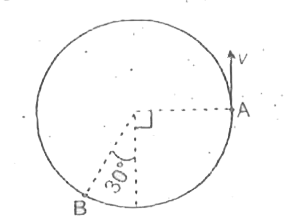A particle of mass m is tied to light string and rotated with a speed v along a circular path of radius r. If T=tension in the string and mg= gravitational force on the particle then actual forces acting on the particle are
mg and T only
mg T and on additional force of mv2r directed inwards.
mg, T and an additional force of mv2r directed outwards.
only a force mv2r directed outwards
The correct Answer is:A
To solve the problem, we need to analyze the forces acting on a particle of mass m that is tied to a light string and rotated in a circular path with a speed v and radius r.
1. Identify the Forces Acting on the Particle:
- The particle experiences two main forces:
- The gravitational force acting downward, which is mg.
- The tension T in the string acting upward.
2. Draw the Free Body Diagram:
- Draw the particle and indicate the forces:
- An arrow pointing downwards labeled mg.
- An arrow pointing upwards labeled T.
3. Understand Circular Motion:
- For an object moving in a circular path, a centripetal force is required to keep it in motion. This force is directed towards the center of the circular path.
- The required centripetal force Fc can be expressed as:
Fc=mv2r
4. Resolve the Tension Force:
- The tension T in the string can be resolved into two components:
- A vertical component Tcosθ that balances the gravitational force mg.
- A horizontal component Tsinθ that provides the necessary centripetal force.
- Therefore, we can write:
Tcosθ=mg(1)
Tsinθ=mv2r(2)
5. Equilibrium in the Vertical Direction:
- Since the particle is in equilibrium in the vertical direction, the upward force (tension component) must equal the downward force (weight):
Tcosθ=mg
6. Centripetal Force Requirement:
- The horizontal component of tension provides the centripetal force necessary for circular motion:
Tsinθ=mv2r
7. Conclusion:
- The actual forces acting on the particle are the gravitational force mg and the tension T in the string. Thus, the answer to the question is:
The actual forces acting on the particle are mg and T only.
- The particle experiences two main forces:
- The gravitational force acting downward, which is mg.
- The tension T in the string acting upward.
- Draw the particle and indicate the forces:
- An arrow pointing downwards labeled mg.
- An arrow pointing upwards labeled T.
- For an object moving in a circular path, a centripetal force is required to keep it in motion. This force is directed towards the center of the circular path.
- The required centripetal force Fc can be expressed as:
Fc=mv2r
- The tension T in the string can be resolved into two components:
- A vertical component Tcosθ that balances the gravitational force mg.
- A horizontal component Tsinθ that provides the necessary centripetal force.
- Therefore, we can write:
Tcosθ=mg(1)
Tsinθ=mv2r(2)
- Since the particle is in equilibrium in the vertical direction, the upward force (tension component) must equal the downward force (weight):
Tcosθ=mg
- The horizontal component of tension provides the centripetal force necessary for circular motion:
Tsinθ=mv2r
- The actual forces acting on the particle are the gravitational force mg and the tension T in the string. Thus, the answer to the question is:
The actual forces acting on the particle are mg and T only.
Topper's Solved these Questions
- CIRCULAR MOTIONBOOK - ALLENCHAPTER - CIRCULAR MOTIONEXERCISE - MCQ
14 Videos
- CIRCULAR MOTIONBOOK - ALLENCHAPTER - CIRCULAR MOTIONEXERCISE - Martrix match
1 Videos
- CIRCULAR MOTIONBOOK - ALLENCHAPTER - CIRCULAR MOTIONEXERCISE - EXERCISE(S-2)
6 Videos
- BASIC MATHSBOOK - ALLENCHAPTER - BASIC MATHSEXERCISE - Question
1 Videos
- CURRENT ELECTRICITYBOOK - ALLENCHAPTER - CURRENT ELECTRICITYEXERCISE - EX.II
66 Videos
Similar Questions
Knowledge Check
A particle travels in a circular path of radius 0.2 m with a constant kinetic energy of 4J . What is the net force on the particle?
A4NB16NC20ND40N
A particle of mass m moves with constant speed v on a circular path of radius r. Find magnitude of average force on it in half revolution.
View SolutionA particle of mass m moves with constant speed v on a circular path of radius r as shown in figure. The average force on it during its motion from A to B is

View SolutionA paticle of mass m is executing uniform circular motion on a path of radius r. If p is the magnitude of its linear momentum, then the radial force acting on the particle is
View SolutionA particle of mass m is tied to a string of length L and whirled into a horizontal plan. If tension in the string is T then the speed of the particle will be :
View SolutionA particle of mass 100 g tied to a string is rotated along the circle of radius 0.5 m. The breaking tension of the string is 10 N. The maximum speed with which particle can be rotated without breaking the string is
View SolutionA particle of mass m is being circulated on a vertical circle of radius r. If the speed of particle at the highest point be v, then
View SolutionA particle of mass m is rotating in a plane in circular path of radius r. Its angular momentum is L. The centripetal force acting on the particle is
View Solution
